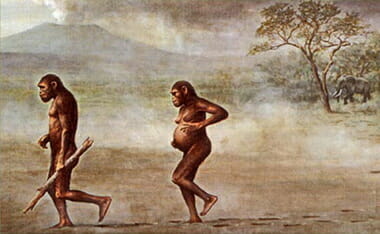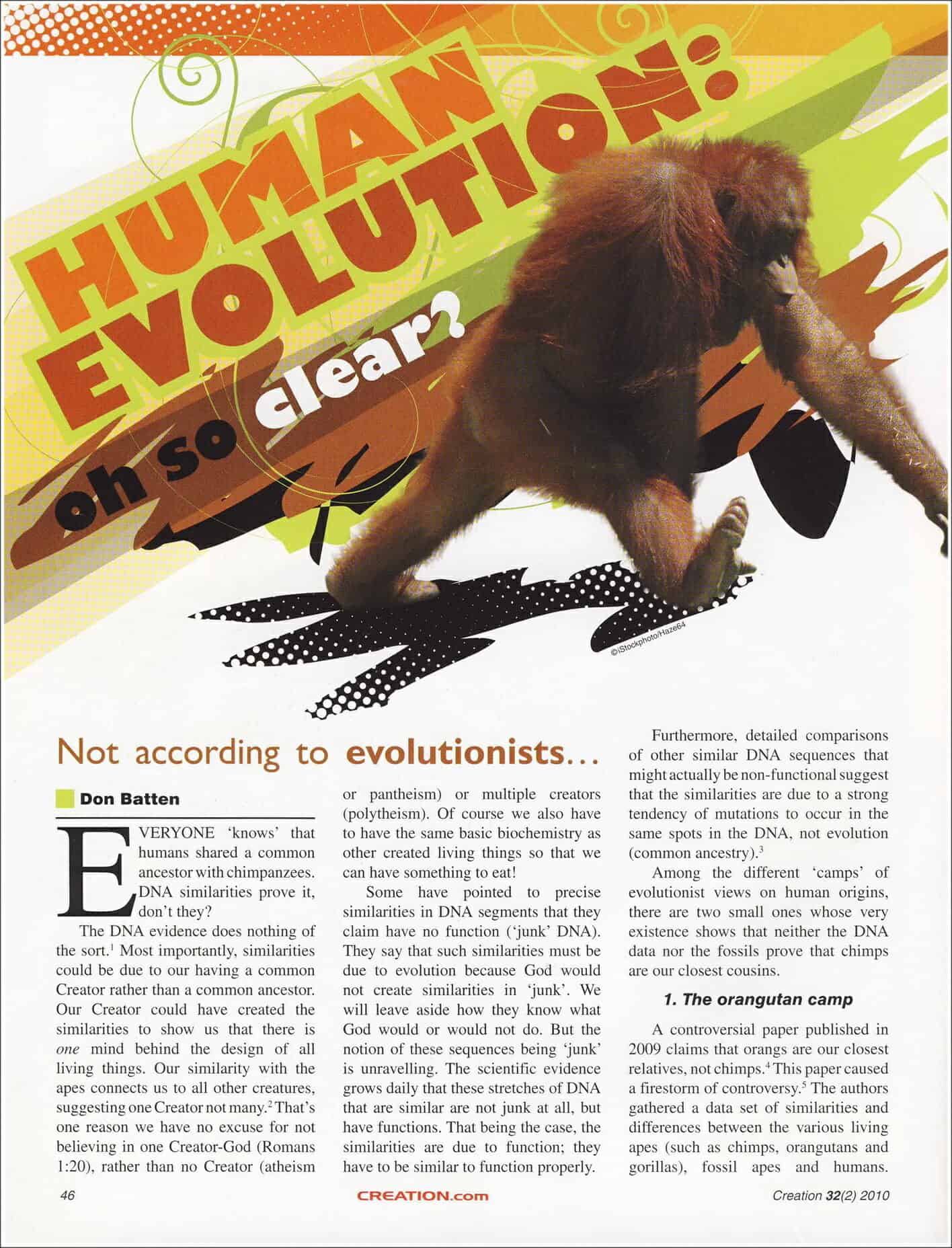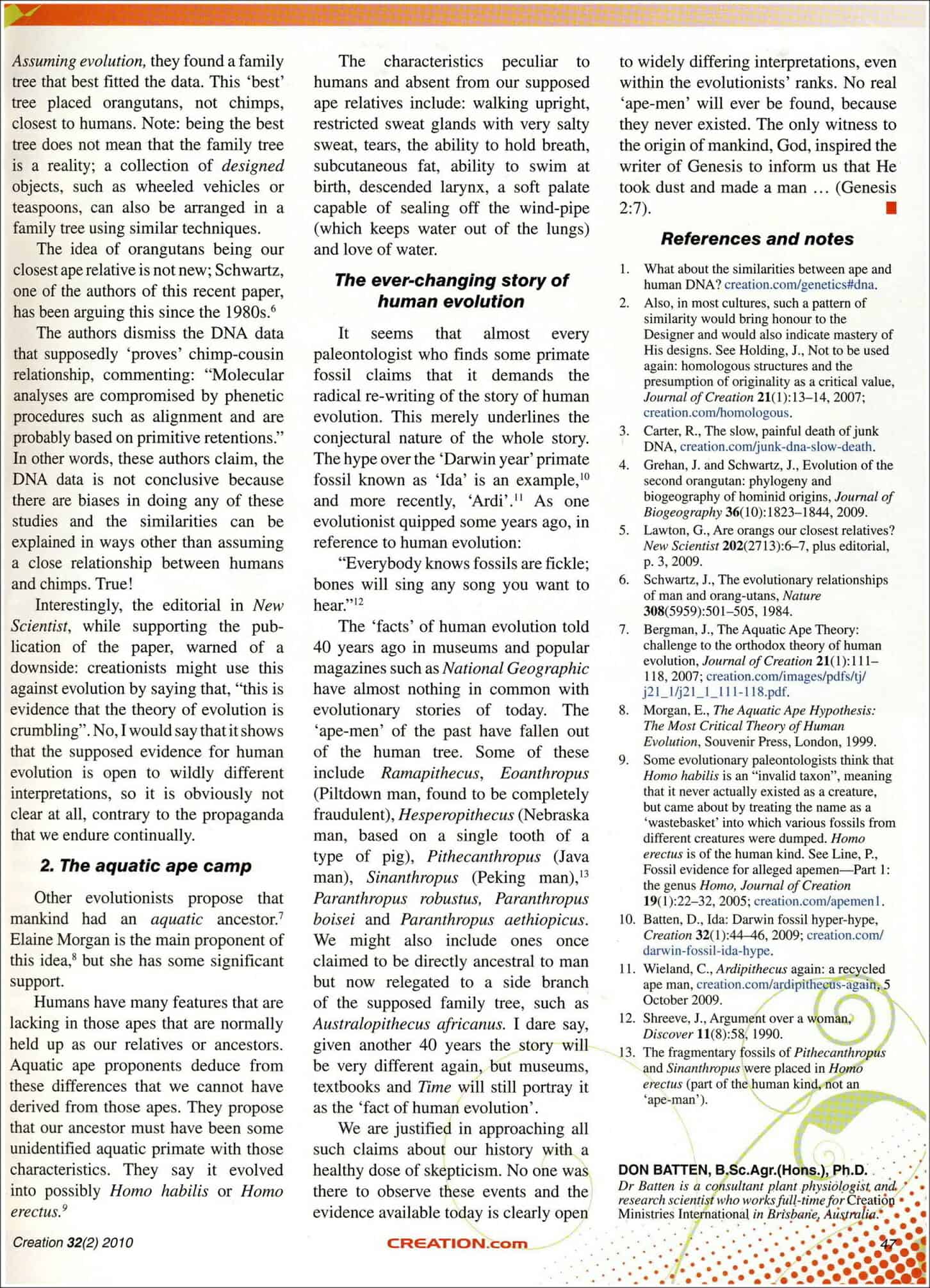So you can see JUST how arbitrary historical science is (Darwinian evolution in this case), scientists have just doubled the age of man, via Creation Research Society’s, Creation Matters newsletter (July/Aug 2014, Volume 19, Number 4) ~ “Your Inner Ape Just Got Older”:
Evolutionists have doubled their date of the chimp-human split from 7 million to 13 million years ago. How, and why? National Geographic announces gleefully, with a picture of a chimp playing with a child, “Ancient Human-Chimp Link Pushed Back Millions of Years.”1 Based on a study of chimp genes in Science,2 …
[….]
The new estimate is based on current mutation rates in the sample, but a lead author confessed, “We also don’t know if mutation rates varied widely in the ancient past; maybe they were different than now.”
1. Vergano, D. (2014, June 12) Ancient human-chimp link pushed back millionsof years: Older male chimps sped evolution and reset era of our last commonancestor with apes. National Geographic Daily News. Retrieved June20, 2014 from http://news.nationalgeographic.com/news/2014/06/140612-chimp-father-evolution-human-science/
2. Venn, O., I. Turner, I. Mathieson, N. de Groot, R. Bontrop, and G. McVean.2014. Nonhuman genetics. Strong male bias drives germline mutation inchimpanzees. Science 344(6189):1272–1275.
Two observations… the first one being in a form of a question:
- “Does this cause an increase in confidence towards neo-Darwinian ‘science’ showing evidence of early evolutionary man and ‘his’ origins? Or does the above cause less confidence in the origin of mankind’s history, according to an evolutionary past?”
I argue it cause less confidence. Why? — you so astutely ask. This is why: ALL the evidences and previous timelines based on a wide variety of work from archaeology, paleontology, and dating methods used to date man’s time-table… are thrown out. Why does science, so called, make such giant leaps (remember that the age of the Virgo Cluster being essentially chopped in half?)? Because the previous evidence is shoddy, and very, very subjective.
The second commentary is at least an honest admission from the researchers. I wish such honesty existed in the dating community… not the dating community as in male/female. But the dating community in the radioactive measurements. Even Forbes Magazine is catching up to the idea:
One of the first things that Physics students learn when they study radioactivity is the idea of the half-life. A half-life is the period of time in which it takes one-half of a given amount of a radioactive substance to decay. Radioactive decay happens when a radioactive substance emits a particle. It’s impossible to predict exactly when a given atom of a substance will emit a particular particle, but the decay rate itself over a long period of time is constant.
Or, at least, that’s what we thought. But if physicists at Stanford and Purdue are correct in their findings, the whole theory of constant radioactive decay rates could be thrown out the door.
The story begins, as scientific discoveries often do, randomly. Literally, in this case. The team of physicists was investigating the possibility of using radioactive decay rates to generate random numbers, since the rate is constant but the emission of individual atoms is unpredictable, it seemed like a perfect fit.
Then came the problem:
As the researchers pored through published data on specific isotopes, they found disagreement in the measured decay rates – odd for supposed physical constants.
Checking data collected at Brookhaven National Laboratory on Long Island and the Federal Physical and Technical Institute in Germany, they came across something even more surprising: long-term observation of the decay rate of silicon-32 and radium-226 seemed to show a small seasonal variation. The decay rate was ever so slightly faster in winter than in summer.
Was this fluctuation real, or was it merely a glitch in the equipment used to measure the decay, induced by the change of seasons, with the accompanying changes in temperature and humidity?
As it turns out, they probably aren’t….
As you can see in my more lengthy dealing with the matter as a supplement to a men’s group at church, the assumption of continuous decay rates at the present — observable — rates applied to the past is a HUGE assumption that is not scientific at all. Here are other “icons of evolution” decunstructed:
A great magazine for all ages: click to enlarge


